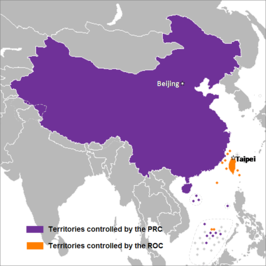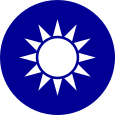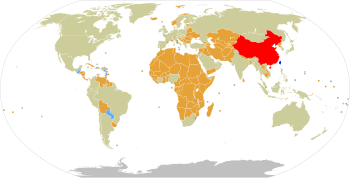Two Chinas
This articleneeds additional citations forverification.(February 2021) |
| Two Chinas | |||||||||||||
|---|---|---|---|---|---|---|---|---|---|---|---|---|---|
 Territories controlled by thePeople's Republic of China (PRC)(purple) and theRepublic of China (ROC)(orange). The size of minor islands controlled by the PRC, the ROC, and other countries (gray) has been exaggerated in this map for ease of identification. | |||||||||||||
| Traditional Chinese | Hai cái Trung Quốc | ||||||||||||
| Simplified Chinese | Hai cái Trung Quốc | ||||||||||||
| |||||||||||||
 |
|---|
|
|
 |
|---|
|
|
The term "Two Chinas"refers to the geopolitical situation where two political entities exist under the name"China".[1][2]
Background[edit]
In 1912, theXuantong Emperorabdicated as a result of theXinhai Revolution,and theRepublic of Chinawas established inNanjingby revolutionaries underSun Yat-sen.At the same time, theBeiyang government,led byYuan Shikai,a formerQing dynastygeneral, existed inBeijing,whose legitimacy was challenged by theNationalist governmentunder theKuomintang(Chinese Nationalist Party).
From 1912 to 1949, China was scarred bywarlords,theJapanese invasionand theChinese Civil War.Throughout this turbulent period, various multiple governments existed in China. These include Yuan Shikai's Beiyang government (1912–1928), theChinese Soviet Republic(1931–1937) established by theChinese Communist Party(CCP),[4]the puppet states ofManchukuo(1932–1945) andMeng gian g(1939–1945), theFu gian People's Government(1933–1934),Wang Jingwei'sJapanese-sponsored puppet government(1940–1945),Ganden Phodrang'sTibet(1912–1951),Khoja Niyaz'sTurkic Islamic Republic of East Turkestan(1933–1934), theSoviet-backedEast Turkestan Republic(1944–1949), theTuvan People's Republic(1921–1944),Bogd Khan'sMongolian StateinOuter Mongolia(1911–1924) and theMongolian People's Republic(1924–1992), with the latter recognized by China in 1946.
As the Chinese Civil War ended in 1949, the Chinese communistPeople's Republic of China(PRC), led byCCP ChairmanMao Zedong,took control ofMainland China.TheRepublic of China,led byPresidentChiang Kai-shek,retreatedthegovernment of the Republic of Chinato the island ofTaiwan,hence effectively dividing China into two political states[a],similar toNorth and South Korea,West and East GermanyandNorth and South Vietnam.
Though fighting continued for the next several years, by the time of theKorean Warthe lines of control were sharply drawn: the Communist-led People's Republic of China government in Beijing controlled most of mainland China, while the Kuomintang-ledRepublic of Chinagovernment, now inTaipei,controlled theisland of Taiwan,some surrounding islands, and a number of islands off the coast ofFu gian.This stalemate was enforced with the assistance of theUnited Statesgovernment thatbegan deterring an invasion of Taiwanafter the start of the Korean War.
For many years, both governments contended to be the sole legitimate government of China. With the fighting largely over, the major battleground became diplomatic. Before the 1970s, the Republic of China was still recognized by many countries and the United Nations as the sole legitimate government of "China", which claimed sovereignty over both mainland China and Taiwan. The Republic of China had been a founding member of theUnited Nationsand was one of the five permanent members of the Security Council until 1971, when they were expelled from the UN and China's representation was replaced by the People's Republic of China (PRC) viaUN General Assembly Resolution 2758.Before the 1970s, few foreign governments recognised the People's Republic of China. The first governments to recognise it as the government of "China" wereSoviet bloccountries, members of thenon-aligned movement,and theUnited Kingdom(1950). The catalyst to change came in 1971, when theUnited Nations General Assemblyexpelledrepresentatives of Chiang Kai-shek by refusing to recognise their accreditations as representatives of China. Recognition for the People's Republic of China soon followed from most other governments, including the United States. The Republic of China continued to compete with the People's Republic of China (PRC) to be recognised as the legitimate government of China.
Since the 1990s, however, a rising movement for formal recognition of Taiwanese independence has made the political status of Taiwan the dominant issue, replacing the debate about the legitimate government of China. A view in Taiwan is that the Republic of China and the People's Republic of China are bothsovereign,thus forming "two Chinas", or "one China, one Taiwan". Former Republic of China President Chen Shui-bian adamantly supported this status quo, and accordingly largely abandoned the campaign for the Republic of China to be recognised as the sole legitimate government of China. Under President Chen, the ROC government was campaigning for the Republic of China to join the United Nations as representative of its effective territory—Taiwan and nearby islands—only. Chen's successor, PresidentMa Ying-jeou,ceased that push.[citation needed]
Current situation[edit]

In the past, both the People's Republic of China (PRC) and the Republic of China (ROC) have claimedde juresovereignty over all of China whilst denying the legitimacy of the other.[5][6]The position of the PRC and thePan-Blue Coalitionof the ROC remains that there is only one sovereign entity of China, and that each of them represents the legitimate government of all of China—including both mainland China and Taiwan—and the other is illegitimate. The position of thePan-Green Coalitionof the ROC is that Taiwan is an independent sovereign state named "Republic of China", and Taiwan is not part of "China". As of 2024, 178 UN member states and theState of Palestinemaintain diplomatic relation with the PRC. 11 UN member states and theHoly Seemaintain diplomatic relation with the ROC.
People's Republic of China[edit]
Thegovernment of the People's Republic of China(PRC) opposes treating the Republic of China (ROC) as a legitimate state and portrays Taiwan as a rogue province of the PRC.[7]The People's Republic of China government has consistently opposed "two Chinas", instead espousing that all of "China" is under one single, indivisible sovereignty under its "One China Principle",explicitly including Taiwan. Under this principle, while the PRC has node factocontrol over territory administered by the ROC, the PRC nevertheless claims that the territories controlled by both the PRC and ROC are part of the same, indivisible sovereign entity "China".[8][9]
PRC government policy mandates that any country that wishes to establish a diplomatic relationship with the PRC must first discontinue any formal relationship with the ROC. According toThe Fletcher Forum of World Affairs,"non-recognition of the Taiwanese government is a prerequisite for conducting formal diplomatic relations with the PRC—in effect forcing other governments to choose between Beijing and Taipei."[10][11]In order to compete for other countries' recognition, each government has given money to certain small countries. Several small African and Caribbean countries have established and discontinued diplomatic relationships with both sides several times in exchange for huge financial support from each side.[12]The PRC also uses its international influence to prohibit the ROC from entering international events such as theOlympic Gamesunder its official name. Instead, the ROC was forced to adopt the nameChinese Taipeito enter such events since the 1980s.[13]Furthermore, on press releases and other media, the PRC never refers to the ROC as such, instead referring to the territory of Taiwan as "China's Taiwan Province", and to the ROC government as "the Taiwan authority".[citation needed]
Republic of China[edit]
Until the constitutional reforms of 1991, the Republic of China (ROC) actively asserted its claim of sovereignty over all of China and still opposes treating the People's Republic of China (PRC) as a legitimate state. ROC authorities clarified the constitutional reforms by stating they do not "dispute the fact that the PRC controls mainland China."[14]Since then, the ROC has neither actively asserted these claims nor denied them. Democratization and liberalization offree speechhas led to the emergence of theTaiwan independence movement,which supports the idea of "Two Chinas". The ROC's position with respect to "Two Chinas" has varied by administration, withPan-Greenadministrations favoring it andPan-Blueadministrations preferring the position of One China with respective interpretations.
In 1999, thenPresidentLee Teng-huidefined the relationship as "Special state-to-state relations".
PresidentChen Shui-biandeclared in 2002 that "with Taiwan and China on each side of the Taiwan Strait, each side is a country".In 2003 he explained that" Taiwan is not a province of one country nor is it a state of another ".[15][16]The Chen administration took steps to use the name "Taiwan" internationally to prevent confusion between the "two Chinas", such as placing the word "Taiwan" underneath "Republic of China" onRepublic of China passports.[17]
In September 2008 PresidentMa Ying-jeoufrom theKuomintangstated that the relations between the ROC and the PRC are neither between two Chinas nor two states, saying instead that it is a "special relationship".Further, he stated that the sovereignty issues between the two cannot be resolved at present, but he quoted the1992 Consensusas a temporary measure until a solution becomes available.[18]The spokesman for the ROC Presidential Office Wang Yu-chi (Chinese:Vương úc kỳ) later clarified the President's statement and said that the relations are between two regions of one country, based on the ROC Constitutional position, the Statute Governing the Relations Between the Peoples of the Taiwan Area and Mainland Area and the 1992 Consensus.[19]
PresidentTsai Ing-wenof theDemocratic Progressive Partywas elected in 2016 and has refused to recognize the1992 Consensus.[20]Under the Tsai administration, the English words "Republic of China" were reduced in size onTaiwanese passports,though the corresponding Chinese characters remained unchanged.[21]
See also[edit]
Notes[edit]
References[edit]
- ^Gayner, Jeffrey B (2 July 1977)."U.S. Diplomacy and the Two Chinas".Archivedfrom the original on 18 January 2021.Retrieved19 March2021.
- ^Swift, John (2003)."The Two Chinas".The Palgrave Concise Historical Atlas of the Cold War.pp. 44–45.doi:10.1057/9780230001183_20.ISBN978-0-333-99404-7.Archivedfrom the original on 2023-04-11.Retrieved2021-02-11.
- ^"At the Edge of State Control: The Creation of the" Matsu Islands "".Taiwan Insight.University of NottinghamTaiwan Studies Programme. 2021-09-13.Retrieved2023-05-21.
Taiwan was a colony of Japan, whereas Matsu was part of Fu gian
- ^Lyman P. Van Slyke,The Chinese Communist movement: a report of the United States War Department, July 1945,Stanford University Press, 1968, p. 44
- ^Hudson, Christopher (2014).The China Handbook.Routledge. p. 59.ISBN9781134269662.Archivedfrom the original on 2023-04-10.Retrieved2021-06-28.
- ^Rigger, Shelley(2002).Politics in Taiwan: Voting for Reform.Routledge. p. 60.ISBN9781134692972.Archivedfrom the original on 2023-04-10.Retrieved2021-06-28.
- ^"CONSTITUTION OF THE PEOPLE'S REPUBLIC OF CHINA".The People's Daily.1982-12-04.Archivedfrom the original on 2010-08-12.Retrieved2016-05-11.
- ^"CONSTITUTION OF THE PEOPLE'S REPUBLIC OF CHINA".The People's Daily — Read 3rd paragraph, 10th line-. 1982-12-04.Archivedfrom the original on 2010-08-12.Retrieved2016-05-11.
- ^"Anti-Secession Law".The People's Daily.2005-03-14.Archivedfrom the original on 2009-08-02.Retrieved2016-05-11.
- ^Erikson, Daniel P.; Chen, Janice (2007). "China, Taiwan, and the Battle for Latin America".The Fletcher Forum of World Affairs.31(2): 71.
- ^"The One-China Principle and the Taiwan Issue".China Internet Information Center.Archivedfrom the original on 2019-02-27.Retrieved2014-04-09.
- ^"China and Taiwan in Africa".HiiDunia. Archived fromthe originalon 2014-04-13.Retrieved2014-04-09.
- ^Catherine K. Lin (2008-08-05)."How 'Chinese Taipei' came about".Taipei Times.Archivedfrom the original on 2021-06-17.Retrieved2016-05-11.
- ^"TAIWAN (REPUBLIC OF CHINA): Constitution, Government & Legislation".Jurist Legal intelligence, Pitt University.Archivedfrom the original on 8 April 2011.Retrieved30 July2011.
- ^
"Extracted text of the telecast relating to cross-strait relations"(in Chinese). Mainland Affairs Council of Republic of China. 2002-08-03. Archived fromthe originalon 2004-12-17.Retrieved2009-08-14.
Đài Loan không phải người khác một bộ phận; không phải người khác địa phương chính phủ, người khác một tỉnh
- ^Wang, James (2003-10-22)."Fortune will favor a brave Taiwan".Taipei Times.Archivedfrom the original on 2015-02-05.Retrieved2013-03-09.
- ^"Chang gives his approval to passports".taipeitimes.Taipei Times. 15 January 2002.Archivedfrom the original on 1 January 2019.Retrieved1 January2019.
- ^"Taiwan and China in 'special relations': Ma".China Post.2008-09-04.Archivedfrom the original on 2008-09-06.Retrieved2008-09-24.
- ^"Presidential Office defends Ma".Taipei Times.2008-09-05.Archivedfrom the original on 2008-09-11.Retrieved2008-09-24.
- ^"Taiwan opposition candidate calls for return to one China formula".Reuters.November 14, 2019.Archivedfrom the original on December 7, 2019.RetrievedFebruary 17,2020– via reuters.
- ^"Taiwan's redesigned passport shrinks words 'Republic of China'".BBC News.2020-09-02.Retrieved2023-04-16.


